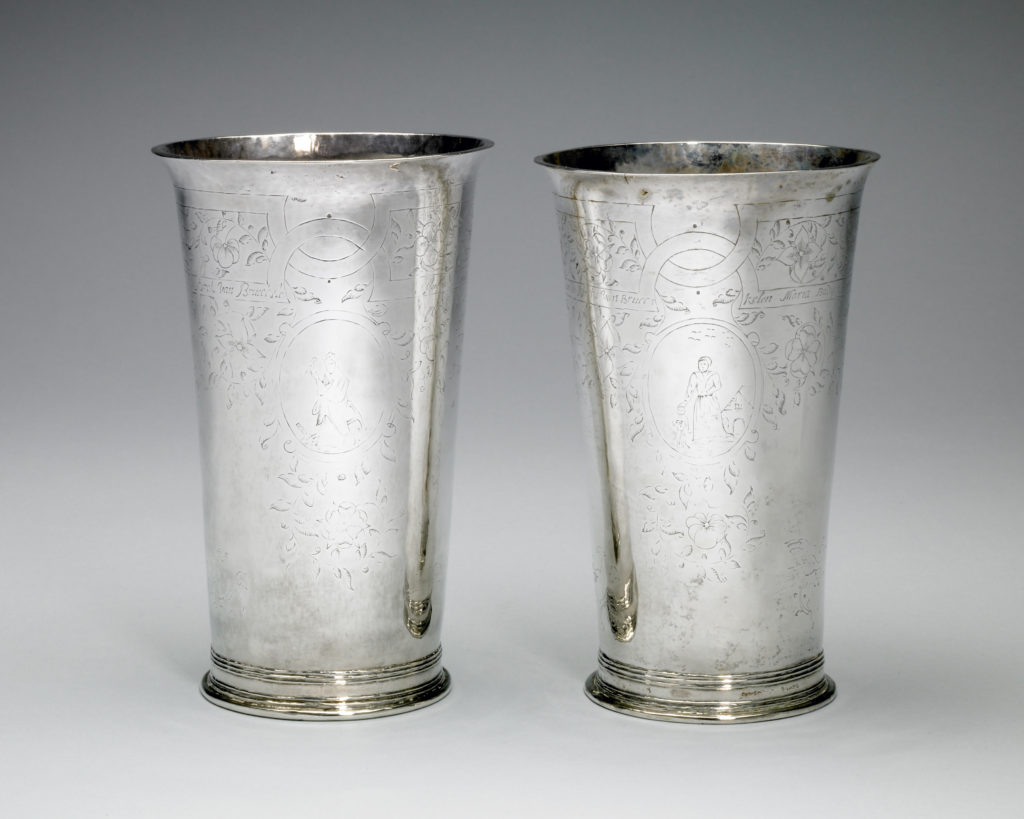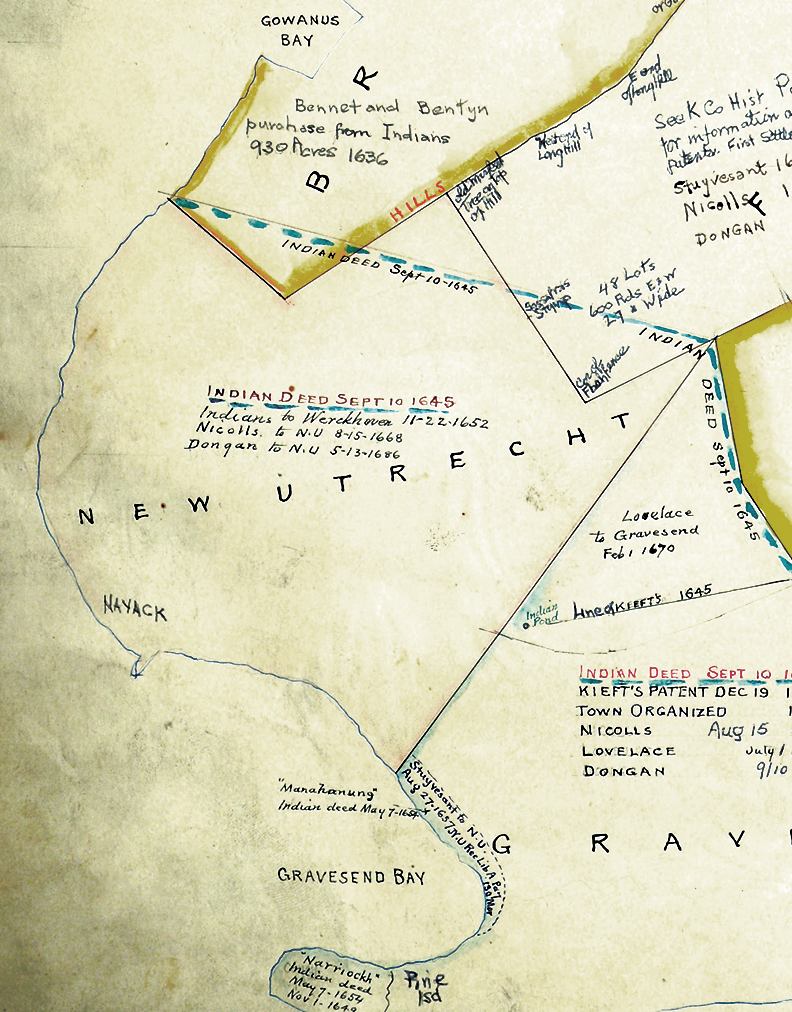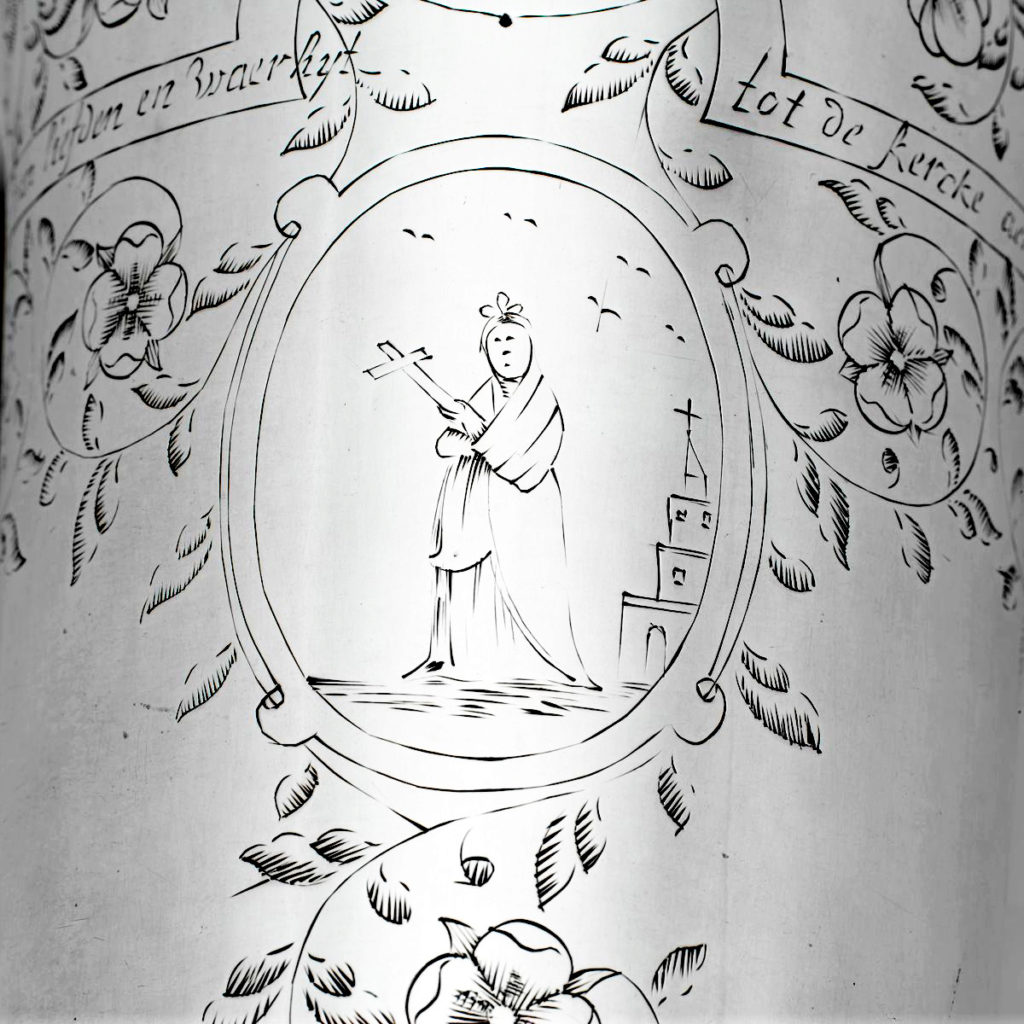Maria Thomas Badie, Silver Beaker Donor of 1684

The donor of two communion beakers to the Reformed Dutch Church of Breuckelen in 1684, Maria Badie, was named, but more than that was unknown, according to our Pastor Meeter a few Sundays ago.
Challenge: who was the woman behind our communion beakers?
Research led us to Maria Thomas Badie, a wealthy woman who was married three times. In surviving legal documents, Maria used Thomas or Badie as her surname, not those of her husbands. In records, the most common variants of her name are:
- Maria Thomas Badie
- Mary Badie
- Mary Badye
- Mary Thomas
- Maria Thomas
- Maritie Tomas
She had 13 children, ten surviving to adulthood. All ten married and had children. Doing some quick math, easily, nearly 100,000 persons living today can claim ancestry.
Maria Badie’s parents were Thomas Badie and Ailtje Braconie (aka Aeltien Brackhonge). The couple were French Huguenots living in Belgium, who emigrated to the Netherlands before embarking for New Amsterdam. The family must have come to New Amsterdam early in the 1620s if one follows a timeline relating to other events. There is no certainty however, of these origins, the case is built upon piecing together from various stories and records.
Thomas Badie was Ailtje’s first husband and searching through records no other child has been found. When he passed, Ailtje inherited the estate. She married two more times, to Cornelis Lambertszen Cool and to Willem Bredenbent. While Lambertszen may have had other children, none seem to have survived, making Maria the only heir, Ailtje having had no children by her third and last husband. Ailtje and Willem’s joint will in 1670 left everything to Marie.[1]
Maria’s first husband was Jacob Verdon, a Frenchman by whom she had two children, Thomas and Magdalena.[2] The first was born around 1627 so the marriage could have occurred in either Amsterdam or New Amsterdam. Verdon was employed with the Dutch West India Company and traveled between the two cities. He died circa 1633.
Around 1634/35, Marie Badie married William Adriaense Bennet, the year based on the birth of their first child in about 1636. Several references state that William was an Englishman[3] others that he was from Denmark. However, the Huguenots claim him as one of their own and give the following information: “Willem Adriaense Be(n)net, born ca. 1605/10 probably in the Netherlands, son of Adrian Benet, a Frenchman. The family used Adrianse as a surname in New Netherlands [using Dutch protocol], then Bennet after the British took control of the colony in 1636. He was a cooper.”[4]

There is a surviving record dated 1636 for land purchased with a partner, Jacques Bentyn, from the Keskaechqucrem tribe (the Canarsie): 930 acres at Gowanus, the two having received a patent from Governor Willem Kieft.[5] On December 26, 1639, Bennet bought out his partner.[6] He built his home at what is now the corner of Third Avenue near 28th Street. This house was burned down during the Indian wars of 1643, during the uprisings provoked by Kieft, who had angered the natives with unjustifiable attacks and murders.[7] Bennet was killed by the Canarsie in 1643/44.[8]
Of their five children, three survived to adulthood: Adriaen, William, and Marritje.[9] Each married and had children.
The lands designated on Graham’s map as “in possession of Willem Ariaense Bennet” were patented by Kieft on September 9, 1664, to “Mary Thomas (sometimes called Mary Badye), widow of Willem Arisense Bennet, deceased, being the land between 28th and 41st streets….”[10]
“Maria Thomas, widow of Willem de Cuper” [William the Cooper] was married for a third time in 1644 to a younger man, the bachelor Paulus van der Beeck, a wealthy German recently arrived from Breman. He was a farmer and also held an official position giving rise to frequent prosecutorial appearances in court. He owned several lots in Manhattan where he resided.[11]
Paulus and Maria had six children[12] baptized at the Collegiate Church, records held by Marble Collegiate. All but one married and had children.
In January of 1663 there began a court action concerning patrimonial rights, initiated by the heirs of Jacob Verdon and William Adriaense Bennet against Paulus van der Beeck. By virtue of his marriage to their mother, Maria Badie, van der Beeck held control of his stepsons’ estate inherited from Bennet while they were minors, but van der Beeck did not relinquish the shares when they reached their majority. Maria’s sons, Adriaen Willemse Bennet, Thomas Verdon, and son-in-law Adam Brouwer appeared before the Court of Breuckelen to gain an order for van der Beeck to turn over their property.[13] Marie testified on her sons’ behalf, and Paulus van der Beeck was ordered to return their shares.[14]
Paulus was rich without keeping Marie’s sons’ property: in 1675 his tax assessment was the tenth highest of New Amsterdam, only nine men paid more. Included in that wealth, he had also retained a share of Marie Badie’s mother and step father’s farm in Gowanus which she had inherited in 1670, for he sold half of it in 1679 to Willem Huycken.[15],[16]
Paulus died about 1680 and is buried in the Flatbush Dutch Reformed Church Cemetery.

In 1684, Marie made the gift of the silver beakers to the Dutch Reformed Church of Breuckelen in celebration of the church’s 30th anniversary. The beakers were made by her son-in-law, Juriaen Blanck Jr. who was a silversmith, married to her daughter Hester van der Beeck. His father, Juriaen Blanck Sr. had also been a silversmith. The father had learned his trade in Amsterdam, Netherlands, and was the first documented silver and goldsmith to practice in New Amsterdam.

We know that Juriaen made other matching beakers, one in 1683, and another in 1711, which are jointly owned by The Metropolitan Museum of Art and The Reformed Protestant Dutch Church, Kingston, New York. They are on view at the museum. Here is a link to the Kingston beakers. Like ours, each is engraved with female representations of Hope, Faith, and Charity and are equally cherished.
Teunis Bergen recorded the year of Maria’s death as 1697.[17] Marie Thomas Badie Verdon Bennet van der Beeck is buried in the Flatbush Dutch Reformed Church Cemetery.
. . .
Blog author Jane Barber has been involved in researching early families related to Old First. Through exploration of her own family line, although there are but a few Huguenots and Dutch in her tree, she knows that two sets of her 8th great grandparents were married at the Flatbush Reformed Church of Breuckelen, in 1663 and 1664 respectively: Jan de la Montangne to Maria Vernlye and Theunis Idens Van Huyse to Janetje Thyssen Laenen Van Pelt. De la Montagne took his wife back to his farm in New Harlem (its location was in what is now Central Park, in the vicinity of the Montayne rivulet, named for the Montagnes). The Van Huyse family were living in New Utrecht by 1670, making it unlikely that either family were still congregants at Flatbush in 1684. However, with friends and other family remaining, Maria Badie included, they or their offspring likely returned for weddings and other ceremonies. It is humbling to contemplate.
[1] “Editorial Iconoclastiana,” The New York Genealogical and Biographical Record, Volume 65, Issue 1, 1934, page 19. Reproduced on findmypast.com.nygbs.idm.oclc.org
[2]“Ben(n)et, Willem Adriaense”, Qualified Huguenot Ancestors of the National Huguenot Society, 5th Edition, 2012.
[3] North America, Family Histories, 1500-2000. ancestry.com
[4] “Ben(n)et, Willem Adriaense”, Qualified Huguenot Ancestors of the National Huguenot Society, 5th Edition, 2012.
[5] “Ben(n)et, Willem Adriaense”, Qualified Huguenot Ancestors of the National Huguenot Society, 5th Edition, 2012.
[6] North America, Family Histories, 1500-2000. ancestry.com
[7] A History of the City of Brooklyn, Including the Old Town and Village of Brooklyn, the Town of Bushwick, and the Village and City of Williamsburgh, Vol. 1, Henry R. Stiles, 1867-70, page 50. googlebooks,com
[8] “Ben(n)et, Willem Adriaense”, Qualified Huguenot Ancestors of the National Huguenot Society, 5th Edition, 2012.
[9] “Ben(n)et, Willem Adriaense”, Qualified Huguenot Ancestors of the National Huguenot Society, 5th Edition, 2012.
[10] A History of the City of Brooklyn, Includingthe Old town and Village of Brooklyn, the Town of Bushwick, and the Village andCity of Williamsburgh, Vol. 1, Henry R. Stiles, 1867-70, page 55. googlebooks.com
[11] Scandinavian Immigrants in New York, 1630-1674. OpenLibrary.org
[12] “Ben(n)et, Willem Adriaense”, Qualified Huguenot Ancestors of the National Huguenot Society, 5th Edition, 2012.
[13] William Adriaense Bennet: Descendants and Related Families, Kenneth Alton Bennett, 1998, page 13.
[14] William Adriaense Bennet: Descendants and Related Families, Kenneth Alton Bennett, 1998, page 13.
[15] William Adriaense Bennet: Descendants and Related Families, Kenneth Alton Bennett, 1998, pages 13 and 14.
[16] The Bergen Family: or The Descendants of Hans Hansen Bergen, Teunis G. Bergen, 1876, page 275.
[17] William Adriaense Bennet: Descendants and Related Families, Kenneth Alton Bennett, 1998, page 14.
